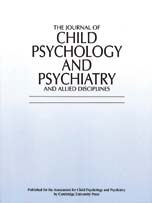Crossref Citations
This article has been cited by the following publications. This list is generated based on data provided by
Crossref.
Yule, William
2002.
Selected Proceedings of the Second International Conference on Child & Adolescent Mental Health.
Vol. 2,
Issue. ,
p.
165.
HSU, CHIA-CHUANG
CHONG, MIAN-YOON
YANG, PINCHEN
and
YEN, CHENG-FANG
2002.
Posttraumatic Stress Disorder Among Adolescent Earthquake Victims in Taiwan.
Journal of the American Academy of Child & Adolescent Psychiatry,
Vol. 41,
Issue. 7,
p.
875.
Norris, Fran H.
Friedman, Matthew J.
and
Watson, Patricia J.
2002.
60,000 Disaster Victims Speak: Part II. Summary and Implications of the Disaster Mental Health Research.
Psychiatry: Interpersonal and Biological Processes,
Vol. 65,
Issue. 3,
p.
240.
Veenema, Tener Goodwin
and
Schroeder-Bruce, Kathryn
2002.
The aftermath of violence: Children, disaster, and posttraumatic stress disorder.
Journal of Pediatric Health Care,
Vol. 16,
Issue. 5,
p.
235.
Mirzamani, Mahmoud
and
Bolton, Derek
2003.
Mothers' Psychological Adjustment Following Disaster Affecting Their Children.
The Journal of Psychology,
Vol. 137,
Issue. 1,
p.
54.
Perrier, Frédéric
and
Nsengiyumva, Jean-Baptiste
2003.
Active science as a contribution to the trauma recovery process: Preliminary indications with orphans from the 1994 genocide in Rwanda.
International Journal of Science Education,
Vol. 25,
Issue. 9,
p.
1111.
Reijneveld, Sijmen A
Crone, Mathilde R
Verhulst, Frank C
and
Verloove-Vanhorick, S Pauline
2003.
The effect of a severe disaster on the mental health of adolescents: a controlled study.
The Lancet,
Vol. 362,
Issue. 9385,
p.
691.
Hoven, Christina W.
Duarte, Cristiane S.
and
Mandell, Donald J.
2003.
Children’s mental health after disasters: The impact of the world trade center attack.
Current Psychiatry Reports,
Vol. 5,
Issue. 2,
p.
101.
Morgan, Louise
Scourfield, Jane
Williams, David
Jasper, Anne
and
Lewis, Glyn
2003.
The Aberfan disaster: 33-year follow-up of survivors.
British Journal of Psychiatry,
Vol. 182,
Issue. 6,
p.
532.
Dyregrov, Atle
Frykholm, Ann‐Margret
Lilled, Lars
Broberg, Anders G.
and
Holmberg, Ingvar
2003.
The Göteborg discothèque fire, 1998.
Scandinavian Journal of Psychology,
Vol. 44,
Issue. 5,
p.
449.
Thabet, Abdel Aziz Mousa
Abed, Yehia
and
Vostanis, Panos
2004.
Comorbidity of PTSD and depression among refugee children during war conflict.
Journal of Child Psychology and Psychiatry,
Vol. 45,
Issue. 3,
p.
533.
Feldman, Betsy J.
Conger, Rand D.
and
Burzette, Rebecca G.
2004.
Traumatic Events, Psychiatric Disorders, and Pathways of Risk and Resilience During the Transition to Adulthood.
Research in Human Development,
Vol. 1,
Issue. 4,
p.
259.
Rosen, Gerald M.
2004.
Posttraumatic Stress Disorder.
p.
85.
Yule, William
Smith, Patrick
and
Perrin, Sean
2004.
Cognitive Behaviour Therapy for Children and Families.
p.
342.
Norris, Fran H.
Murphy, Arthur D.
Baker, Charlene K.
and
Perilla, Julia L.
2004.
Postdisaster PTSD over four waves of a panel study of Mexico's 1999 flood.
Journal of Traumatic Stress,
Vol. 17,
Issue. 4,
p.
283.
Carr, Alan
2004.
Interventions for post-traumatic stress disorder in children and adolescents.
Pediatric Rehabilitation,
Vol. 7,
Issue. 4,
p.
231.
Gil-Rivas, Virginia
Holman, E. Alison
and
Silver, Roxane Cohen
2004.
Adolescent Vulnerability following the September 11th Terrorist Attacks: A Study of Parents and their Children.
Applied Developmental Science,
Vol. 8,
Issue. 3,
p.
130.
Bolton, Derek
Hill, Jonathan
O'Ryan, Dominic
Udwin, Orlee
Boyle, Stephanie
and
Yule, William
2004.
Long‐term effects of psychological trauma on psychosocial functioning.
Journal of Child Psychology and Psychiatry,
Vol. 45,
Issue. 5,
p.
1007.
Broberg, Anders G.
Dyregrov, Atle
and
Lilled, Lars
2005.
The Göteborg discotheque fire: posttraumatic stress, and school adjustment as reported by the primary victims 18 months later.
Journal of Child Psychology and Psychiatry,
Vol. 46,
Issue. 12,
p.
1279.
KAUFMAN, KENNETH R.
and
KAUFMAN, NATHANIEL D.
2005.
CHILDHOOD MOURNING: PROSPECTIVE CASE ANALYSIS OF MULTIPLE LOSSES.
Death Studies,
Vol. 29,
Issue. 3,
p.
237.


